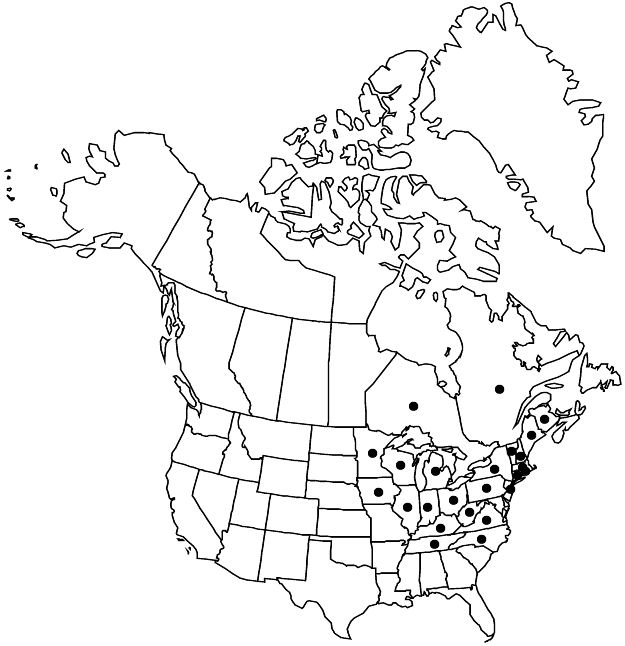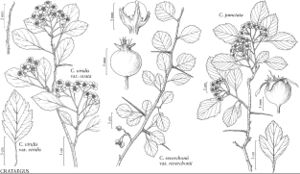Crataegus punctata
Hort. Bot. Vindob. 1: 10, plate 28. 1770.
Shrubs or trees, 40–80 dm. Stems: compound thorns on trunks present; twigs: new growth pubescent, 1-year old pale gray; thorns on twigs usually numerous, ± straight to ± recurved, 1-year old gray, slender, 2–5 cm. Leaves: petiole 0.5–1.5 cm, length 12–20% blade, winged distally, pubescent young, eglandular; blade narrowly obovate to oblanceolate or broadly elliptic, 4–7 cm, equal to or less than 1.5 times as long as wide, base narrowly cuneate, lobes 0 or 5–7 per side distal to widest part of leaf, lobe apex acute, margins sharply serrate to sometimes crenate distally, teeth frequency decreasing proximally, veins 7–10 per side, impressed young, apex subacute to obtuse, abaxial surface sparsely short-pilose except on veins, adaxial matte, sparsely short-pilose, glabrate mature. Inflorescences 10–25-flowered, compact; branches appressed-hairy; bracteoles membranous, margins sessile or short-stipitate-glandular. Flowers 14–19 mm diam.; hypanthium densely pubescent; sepals 6–8 mm, margins entire or subentire, adaxially pubescent proximally; stamens (10–) 20, anthers cream, rose, or pink-purple; styles 3–5. Pomes usually deep burgundy, sometimes scarlet, orange, or yellow, suborbicular, 11–16 (–20) mm diam., punctate, traces of pubescence remaining; sepals reflexed; pyrenes 3–5.2n = 34.
Phenology: Flowering May–Jun; fruiting Sep–Oct.
Habitat: Open sites, fencerows, successional fields, brush, light shade in woodlands, edges of mesic hardwood forests, brushy secondary forests
Elevation: 30–1800 m
Distribution

N.B., Ont., Que., Conn., Ill., Ind., Iowa, Ky., Maine, Mass., Mich., Minn., N.H., N.J., N.Y., N.C., Ohio, Pa., R.I., Tenn., Vt., Va., W.Va., Wis.
Discussion
Crataegus punctata is a common northeastern North American hawthorn, ranging across the northeast quarter of the United States and adjacent Canada to New Brunswick, to North Carolina and Tennessee, occurring mainly above 1000 m in the southern Appalachians. South of New Jersey, it is not found near the coast. The species may occur in nearly pure populations of up to several thousand individuals. The best growth is in sunny sites near streams.
Crataegus punctata is recognized among sympatric species by its matte green leaves (unlike the somewhat similar C. crus-galli) with impressed veins, tabulate branching when grown in the open, usually burgundy fruits with pale dots; the whitish or ashy gray twigs present a distinctive feature in winter (J. B. Phipps et al. 2003, plate 55), responsible for the common name white haw. The similar C. collina, with an allopatric distribution and much earlier flowering season, is often confused with it but is readily differentiated (see key and discussion for that species). Extension-shoot leaves of C. punctata may be very deeply incised with veins to the sinuses, a characteristic not found in C. collina.
Some forms of Crataegus punctata bear scarlet or yellow (var. aurea Aiton) fruit. Hairier forms, especially hairier leaves, have been named var. canescens Britton; very small-leaved forms have been called var. microphylla Sargent. Nearly glabrous forms, all with somewhat glossy foliage, less coarse leaf toothing than C. punctata, and ten stamens, occur sporadically and have been named C. grandis Ashe and var. pausiaca (Ashe) E. J. Palmer. They are probably hybrids with C. crus-galli, as is the similar C. ×disperma, treated under interserial hybrids. The very rare C. ×puberis Sargent is perhaps a hybrid with C. macrosperma, C. ×kellermanii Sargent a hybrid with C. pruinosa, and C. ×neobaxteri Sargent a hybrid with a species of ser. Rotundifoliae.
Selected References
None.
Lower Taxa
"thin" is not a number."winged" is not a number."adnate" is not a number."dm" is not declared as a valid unit of measurement for this property.
